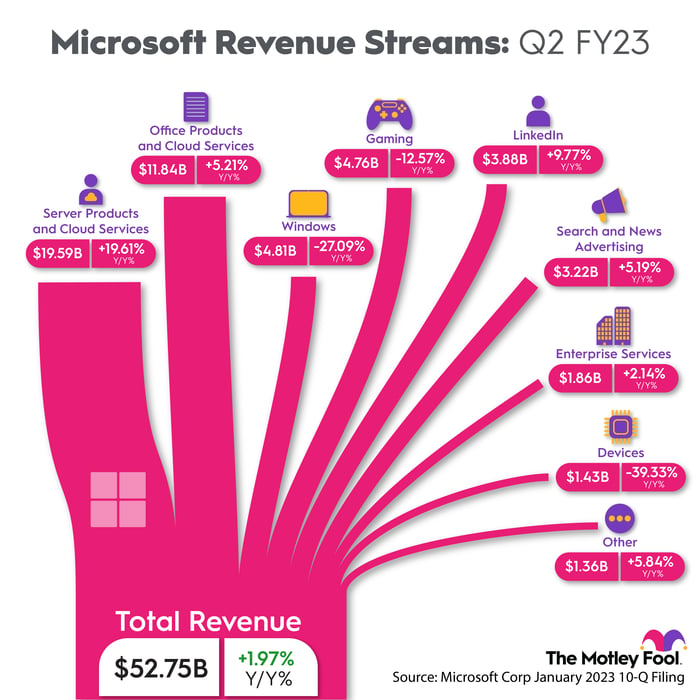Microsoft (NASDAQ: MSFT)'s business has constantly been expanding over the years as it is always in pursuit of new growth opportunities. That's a key reason the stock has been such a phenomenal investment to own; in 10 years, its value has skyrocketed more than 820% (by comparison, the S&P 500 has risen by 150%).
But while the company has been expanding, its revenue comes primarily from just a few main sources. And that's not necessarily a bad thing.
Its core revenue streams provide the business with stability
When Microsoft released its latest quarterly results in January, sales of $52.7 billion for the last three months of 2022 were only up 2% year over year. And the results could have been much worse with Windows-related revenue taking a big hit, declining by a mammoth 27% as light demand for PCs has negatively impacted that area of its business. Device sales also nosedived by 39%, but that accounts for just a small slice of Microsoft's total revenue.
It was the company's core revenue streams that helped ensure the top-line remained higher than it was a year ago.

Image source: The Motley Fool.
Server and office-related products accounted for the bulk of Microsoft's revenue at $31.4 billion, which represented 60% of its top-line. And both those areas of its business showed positive year-over-year growth, with server products and cloud services up nearly 20%.
Cloud computing has been a big growth area for Microsoft in recent years, with Microsoft Azure continuing to lead the business, generating year-over-year growth of 31% last quarter. While device and Windows sales are dependent on consumer demand, office and server products are more resilient as businesses will need to maintain their Office 365 subscriptions and continue to pay for their servers, even in a downturn; those aren't discretionary expenses that companies can easily cut.
A strong foundation can enable the company to continue its pursuit of growth
Microsoft is able to make big moves such as acquiring LinkedIn in 2016 and announcing plans to buy Activision Blizzard because of its strong financials. A business that generates as much in free cash flow as Microsoft does -- $59.6 billion in the trailing 12 months -- won't run out of growth opportunities. While the company does pay a dividend, at $19 billion over the course of four quarters, there's still plenty of free cash left over for the company to invest in itself or to seek out acquisitions.
Acquisitions have helped Microsoft grow both its bottom-line and its cash flow over the ears.
MSFT Free Cash Flow (Quarterly) data by YCharts.
Microsoft remains an excellent buy today
At 28 times earnings, Microsoft isn't a cheap buy. However, given the company's strong financial position and its potential for future growth, it makes for a solid long-term investment as profits are likely to continue rising over the years. Its core businesses in server and office products can help ensure that even if the company's other business segments struggle, Microsoft can still produce strong numbers. And that should give investors plenty of comfort in being able to buy and hold this stock for not just years but potentially decades.
10 stocks we like better than Microsoft
When our award-winning analyst team has a stock tip, it can pay to listen. After all, the newsletter they have run for over a decade, Motley Fool Stock Advisor, has tripled the market.*
They just revealed what they believe are the ten best stocks for investors to buy right now... and Microsoft wasn't one of them! That's right -- they think these 10 stocks are even better buys.
*Stock Advisor returns as of March 8, 2023
David Jagielski has no position in any of the stocks mentioned. The Motley Fool has positions in and recommends Activision Blizzard and Microsoft. The Motley Fool has a disclosure policy.
The views and opinions expressed herein are the views and opinions of the author and do not necessarily reflect those of Nasdaq, Inc.



